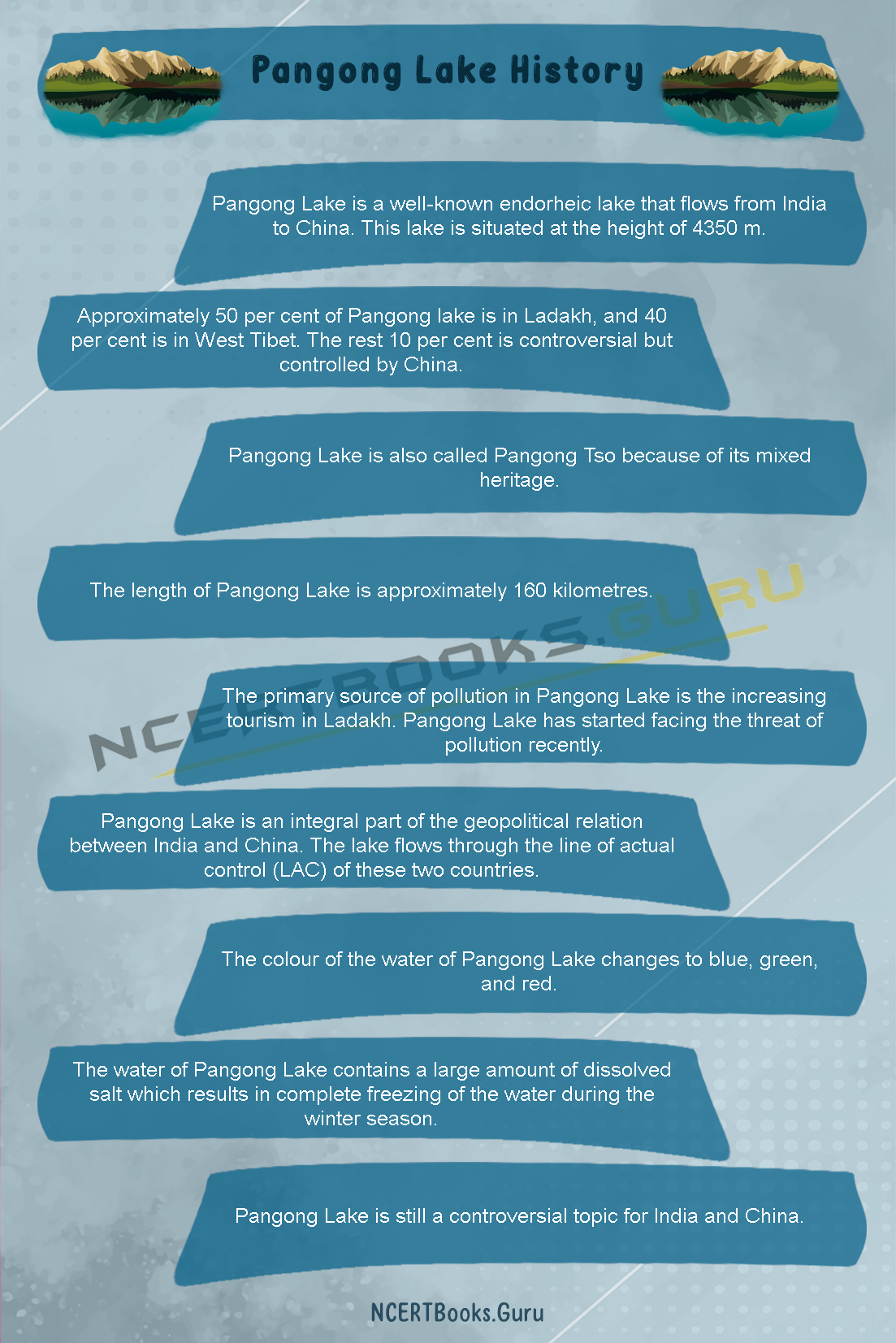Pangong Lake is also called the Pangong Tso. It is an endorheic lake that means it retains the water without any outflow to the outside of it. This lake covers Ladakh and West Tibet. Approximately 50 per cent of this lake is in Ladakh, and 40 per cent is in West Tibet.
The rest 10 per cent is controversial but controlled by China. The water of this lake contains a large amount of dissolved salt which results in complete freezing of the water during the winter season.
Pangong Lake Details
| Countries Covered | India and China |
| Another Name | Pangong Tso |
| Length | Approximately 160 kilometres |
| Height | 4350 meters |
| Colour of Water | Blue, green, and red |
| Reason for pollution | Tourism |
About Pangong Lake
Pangong Lake is a well-known endorheic lake that flows from India to China. This lake is situated at the height of 4350 m. Pangong Lake is one of the popular tourist destinations in India. The aesthetic beauty of Pangong Lake brings many foreigners to visit India.
The lake is in the process of being called a wetland of international significance under the Ramsar Convention. If it happens, Pangong Lake will be the first trans-boundary wetland in South Asia. One of the popular features of this lake is its capacity to change colours. Pangong name came from a Tibetan word, Banggong Co. It means an enchanted and narrow lake.
The one-third portion of this lake lies in India, and China controls the other two-thirds part. Pangong Lake doesn’t have any vegetation and aquatic life because it freezes completely in the winter season due to its saline water. The lake is situated close to the India-China border which makes it a temperate region. Pangong Lake in India has a tranquil surrounding and picturesque landscapes.
Have a look at the List of Important Lakes in India that you need to know for your competitive exams to score well.
Pangong Lake History
The Pangong Lake is situated at the height of 4350 m. This lake covers a total area of approximately 160 kilometres. Pangong lake glitters throughout the day and changes its colour from blue to green as the sunlight skids across its surface. This lake has a rich historical background which makes it a dreamlike beauty. It has immense geopolitical value as well.
Pangong Lake is situated at the actual line of control between India and China. Both the Indian government and the Chinese government are sensitive regarding Pangong Lake. Deldan Namgyal, the king of Ladakh, used to support Bhutan in the Tibet-Indian war in the 17th century. The peeved Tibetans had attacked Ladakh, and Deldan was unable to fight against them. As a result, Deldan looked for assistance from the Mughals.
Ultimately an agreement happened in 1684, and Deldan gave away portions of his territory to the Regent of Tibet. As a result, this lake is divided into India and China. Pangong Lake is still a controversial topic for India and China. Ten percent of this lake is still a matter of debate between these two countries. However, it is controlled by the Chinese government.
Pangong Lake Map
The length of Pangong Lake is approximately 160 kilometres. This lake covers Ladakh and West Tibet. Approximately 50 percent of this lake is in Ladakh, and 40 per cent is in West Tibet.
The rest 10 per cent is controversial but controlled by China. Its water seems sparkling blue in contrast to the arid mountains surrounding it. It is one of the famous lakes in Leh Ladakh. Pangong Lake is a beautiful piece of nature and an attractive tourist hotspot. However, many activities like staying in a hotel or going too far in the lake, and boating is not allowed in this lake due to its controversial geographical location.
The colour of the water of Pangong Lake changes to blue, green, and red. The weather of this lake remains cold, and the water gets frozen during the winter season. In Ladakhi Pangong means extensive concavity. In Tibet, Tso means lake. Pangong Lake is also called Pangong Tso because of its mixed heritage.
Pangong Lake System
The shape of Pangong Lake is like a boomerang. The water of this lake is not drinkable. As the water of the river gets frozen in winter, the vehicular movement also becomes possible in the lake. The lake flows through the actual control between India and China.
Both of these countries have unsettled borders which makes the lake a topic of political controversy. Ten per cent of this lake is patrolled by both India and China. Though this part is not occupied by any of them, it is mainly controlled by China. The situation between both of these countries has not improved yet. The delicate beauty of this lake is featured in a popular Indian movie called ‘3 Idiots’.
Pangong Lake Pollution
The primary source of pollution in Pangong Lake is the increasing tourism in Ladakh. Pangong Lake has started facing the threat of pollution recently. Recent increasing tourism in the Himalayas has contributed to the pollution in Pangong Lake. A vast number of people began visiting Leh Ladakh.
This lake was not popular among Indian tourists until it was filmed in two popular Indian movies, ‘3 Idiots’ and ‘Jab Tak Hai Jan’. According to the officials of Leh, more than six hundred vehicles go to Pangong Lake every day. A large amount of plastic waste flows into the lake. Solid waste is also there on the sides of Pangong Lake. These solid wastes often get carried away by the wind into the lake.
Waste material is collected from the houses and restaurants of this area but dumped in open areas without any treatment. However, the authority is in the process to use mechanisms to treat the waste. Many waste materials mix in the lake through small channels. Many unplanned cafes and hotels have been built up close to the lake. However, the officials of Leh are in the process to create a hundred meters buffer zone between the cafes and the lake.
Pangong Lake Importance
Pangong Lake is an integral part of the geopolitical relation between India and China. The lake flows through the line of actual control (LAC) of these two countries. The Chinese government had built multiple roads on the banks of this lake. This lake has become a hotspot for Indian tourists after the beauty of this wetland got featured in two popular Indian movies, ‘3 Idiots’ and ‘Jab Tak Hai Jan’. However, tourists are allowed only around 7 kilometres of Pangong Lake.
The lake contains saline water. As a result, the water of the river gets frozen during the winter season. So, tourists get the opportunity to do ice-skating and play polo in the lake. The locals also had the opportunity to earn money through tourism in Pangong Lake. Many cafes, hotels, and restaurants have been built up in the Pangong Lake area recently. However, the primary importance of this lake is its geographical location. India and China still do not have a settled border. So, both of the countries use this lake to look over each other.
Short Essay on Pangong Lake
Pangong Lake is a well-known endorheic lake that flows from India to China. This lake is situated at the height of 4350 m. The shape of Pangong Lake is like a boomerang. This lake covers Ladakh and West Tibet. Approximately 50 percent of this lake is in Ladakh, and 40 per cent is in West Tibet.
The rest 10 per cent is controversial but controlled by China. Pangong Lake is an essential part of the geopolitical relation between India and China. The lake flows through the line of actual control (LAC) of these two countries. This lake has a rich historical background which makes it a dreamlike beauty. Deldan, the king of Ladakh, gave away portions of his territory to the Regent of Tibet. As a result, this lake is divided into India and China. Pangong Lake is still a controversial topic for India and China.
Pangong Lake is also called Pangong Tso because of its mixed heritage. The primary source of pollution in Pangong Lake is the increasing tourism in Ladakh. Pangong Lake has started facing the threat of pollution recently. Recent increasing tourism in the Himalayas has contributed to the pollution in Pangong Lake. The lake contains saline water. As a result, the water of the river gets frozen during the winter season. So, tourists get the opportunity to do ice-skating and play polo in the lake.

Ten Lines on Pangong Lake
- Pangong Lake is a well-known endorheic lake that flows from India to China. This lake is situated at the height of 4350 m.
- Pangong lake covers Ladakh and West Tibet.
- Approximately 50 per cent of Pangong lake is in Ladakh, and 40 per cent is in West Tibet. The rest 10 per cent is controversial but controlled by China.
- Pangong Lake is also called Pangong Tso because of its mixed heritage.
- The length of Pangong Lake is approximately 160 kilometres.
- The primary source of pollution in Pangong Lake is the increasing tourism in Ladakh. Pangong Lake has started facing the threat of pollution recently.
- Pangong Lake is an integral part of the geopolitical relation between India and China. The lake flows through the line of actual control (LAC) of these two countries.
- The colour of the water of Pangong Lake changes to blue, green, and red.
- The water of Pangong Lake contains a large amount of dissolved salt which results in complete freezing of the water during the winter season.
- Pangong Lake is still a controversial topic for India and China.
FAQs on Pangong Lake
Question 1.
What is the length of Pangong Lake?
Answer:
The length of Pangong Lake is approximately 160 kilometres.
Question 2.
Why does the water of Pangong Lake get frozen in winter?
Answer:
The water of Pangong Lake contains a large amount of dissolved salt which results in complete freezing of the water during the winter season.
Question 3.
What is the primary source of pollution in Pangong Lake?
Answer:
The primary source of pollution in Pangong Lake is the increasing tourism in Ladakh.
Question 4.
Does the colour of the Pangong Lake change?
Answer:
Yes, the colour of the water of Pangong Lake changes to blue, green, and red.
